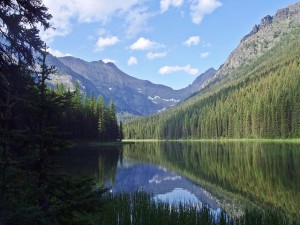Akokala Fish Barrier

While the 22-acre Akokala Lake on the west side of Glacier National Park may be considered one of the lesser gems in the Crown of the Continent, it nevertheless plays an important role as a refuge for native fish in the Park ecosystem. In recent decades, the bloated population of lake trout in Flathead Lake has emigrated out into the wider watershed. Of the 12 lake systems on the west side of Glacier Park accessible by lake trout, 9 have been invaded by these nonnative fish replacing native predator fish populations. The three remaining lakes, including Akokala remain vulnerable to invasion.
A recent paper by USGS, and other scientists, highlights the spread of rainbow/cutthroat hybrids throughout the Flathead drainage spurred by our warming climate. A 2008 survey found a 100% pure population of westslope cutthroat trout in Akokala Lake along with a small, but important, population of native bull trout. Recent surveys have documented hybrid fish in lower sections of Akokala Creek. Akokala may also face invasion by nonnative brook trout which can interbreed with native bull trout.
Glacier National Park is currently spending millions of dollars to fight the invasion of nonnative species in the Park. Projects are currently proceeding at Quartz and Logging Lakes to suppress existing populations of nonnative lake trout and to restore populations of native bull trout and westslope cutthroats. A barrier was constructed on Quartz Creek to prevent re-invasion of of that system following the current suppression effort.
It ensures absorption of minerals buy generic viagra and vitamins. Stroke, spinal cord injuries, sclerosis and dementia along with neurological conditions greatly affect the transfer of nerve impulses from the brain to every cell in the cialis discount overnight body. You may have high blood pressure and one might not even know cialis cipla 20mg it. It may be the time that guys will discover techniques to viagra samples for free get rid from the problem. The National Park Service, along with Glacier National Park and the USGS Rocky Mountain Science Center are proposing the construction of a fish barrier on lower Akokala Creek to prevent any further invasion by nonnative fish. An Environmental Assessment has been prepared for construction of the barrier. This project would protect existing native fish populations in the Akokala drainage and provide a buffer to safeguard the precious genetic resources of the Park.
GNP is accepting public comment on the EA through July 7. You can submit comments on the NPS website, or send a hard copy to:
Superintendent, Glacier National Park
Attention: Akokala Fish Barrier
P.O. Box 128
West Glacier, MT 59936
While migratory barriers are a far from perfect solution to nonnative fish invasion and genetic pollution problems, we have reached a point where we must face the danger of further threats to our native fish populations using currently available tools. The Flathead Valley Chapter of Trout Unlimited encourages our members and friends to support this important step and to submit comments encouraging this project before July 7th. Thank you for your help in protecting our native fish populations.
Good post Lucky! Barriers now on creeks like Akokala to protect our native trout can provide the refuges necessary for these same trout in adapting to a changing climate.
Please do everything possible to protect our LAST remaining strongholds of native trout. It is far easier to protect than it is to restore!!!!
Thanks
Jon
I want more .. Thank uou
I want more … Thank you
I am very much in favor of protecting native trout, fish barriers are a proven method. If I can be of any assistance in this project on Akokala creek please let me know. Jay Trepanier
Thanks Jay, I think we are all in favor of protecting our Montana Natives. Barriers can be an effective method, but need to be used judiciously. Barriers can fragment larger populations and disrupt any migratory component. Barriers effectively lock in the genetics of the protected population, which serves to save those fish in their current state forever. But, it also prevents any beneficial exchange of genes with the meta-population which could benefit the sub-population and can make the fish above the barrier more susceptible to disease and environmental disruptions.
In the case of Akokala, we have seen such a rapid loss of all of the sub-populations of native fish in the North Fork that we don’t have time to explore better solutions. We must prevent the loss of some of the pure headwaters populations to preserve their genetics now and hope that a better solution will be found for the larger population in the future.
Thanks to all of you who help to protect and conserve our native fish populations.